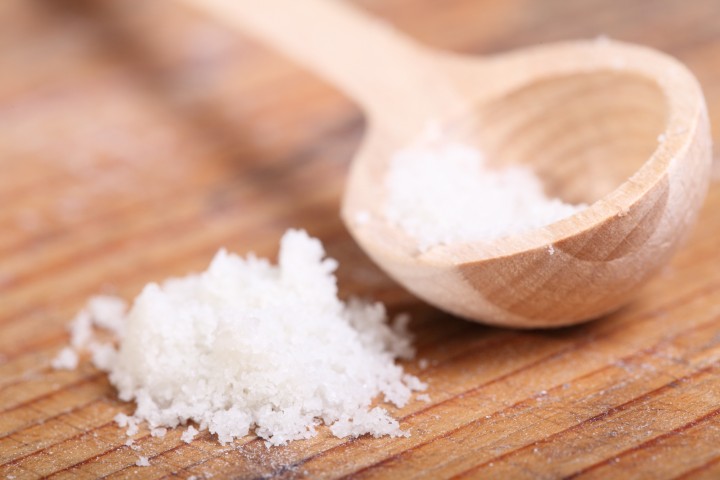
If you want to find out what salt does for your loaf, try and leave it out and take a bite…
Klik hier voor de Nederlandse versie
A while ago we took a closer look at the percentage of salt we put into our bread. If you are a big bread eater, chances are high you get a lot of your daily salt intake via your sandwiches.
The UK recently came out with a new standard for the amount of salt in bread baking. So we tested this new standard to find out what the effect would be for our own bread baking and want to share the result with you…
First, some things you need to know about salt and bread baking:
What does salt do?
- Salt acts as a natural antioxidant in the dough and not only adds taste but especially helps bring out the flavors and aromas present in the flour and other ingredients.
- Next to its role in boosting the flavor of your bread, salt plays a role in tightening the gluten structure and adding strength to your dough. It helps the loaf to hold on to the carbon dioxide gas that is formed during fermentation, supporting good volume.
- Salt slows down fermentation and enzyme activity in dough. The salt crystals draw water away form their environment (salt is ‘hygroscopic’). When salt and yeast compete for water, salt wins and the yeast is slowed down.
- Because of its moisture maintaining properties, salt can prevent bread from getting stale but it can also (this is especially true in humid environments) absorb moisture from the air and leave you with soft crusts and soggy bread.
How much salt is considered normal in bread baking?
In bread baking the percentage of salt added that is considered normal, ranges from 1.8% to 2.2% of the total amount of flour, depending on the recipe and personal preference. Low salt contents can lead to bland loaves, anything over the 2.2% norm will likely be considered too salty. The UK recently came out with a new standard of 1 gram of salt per 100 grams of the final baked bread or about 1.5 to 1.6% of the total amount of flour. So instead of a percentage of salt to flour, they give the amount of salt per 100 gram of the actual finished product / bread.
Should I be afraid of salt touching my yeast?
Short answer: NO! Usually you add salt and yeast to your flour and immediately start mixing. It is totally unnecessary to put salt on one side and yeast on the other and seconds later start mixing them together anyway. You do not want to add salt on top of fresh yeast and leave it for minutes because then the salt will indeed kill the yeast.
What type of salt should I use for bread baking?
All salt is good, as long as the salt crystals are fine enough and dissolve easily. A lot can be said for different types of salt, some contain additives, some have other minerals next to the sodium chloride (NaCl) considered beneficial for you (like Celtic sea salt which is also lower in sodium). You can make up your own mind as far as the health benefits go, taste wise it will not make a big difference to your loaf. Due to the relatively small quantity of salt it would be really hard to detect subtle differences in flavor.
Our own findings with the new salt content standard
So, we looked at our own baking and did a test with this new UK standard of 1 gram salt per 100 grams baked loaf. For example, for a standard pain rustique (750 g dough, weighing about 680 g after baking) this would mean lowering the added salt from 8 g to 6.8 g or from 1.17 g to 1 g per 100 g bread.
Examples of bakers percentages for a loaf of pain rustique:
2.2% of total flour would mean almost 10 g of salt added to the recipe
2% – about 9 g of salt
1.8% – just over 8 g of salt
1.5% – about 6.8 g of salt (the new UK standard)
We tested and tasted the bread with new, lower salt content several times, together with some bread friends. Result: We all had a very hard time noticing any difference. There is a line below which it would become noticeable of course, but this new standard is no problem for us. We have to add that using high quality (organic) flour also makes a big difference in taste and perception of saltiness. Also see our flour experiments. To enhance flavor, salt has to have something to work with, and it will have a hard time bringing out any flavor when the flour you work with is overly processed and bland to begin with!
We now use it in most recipes for our daily bread, except when making dough for things like pizza and focaccia and other flatbreads. For these special breads our personal preference is to make this dough a bit saltier.
Let us know your thoughts on salt!



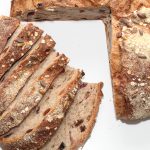

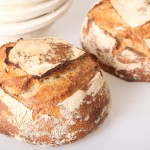
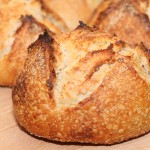
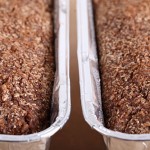

Madelene says
Hi. My homemade bread is good but it taste so plain for example if a person don’t add salt to fresh meat it’s got no taste. My bread don’t have any taste. I’m not sure if I should add more salt and some sugar. I’ve always had good bread over the yrs. Not so much now. What am I doing wrong?
Orange says
Maybe try adding more Sugar or Fat to provide a richer, robust, and more complex flavor profile. Or, add molasses or cinnamon for a more hearty flavor.
Alistair says
Hi,
Just made my first loaf of bread with a bread maker. for a 500g loaf it said to use 8 grams of salt, which I did, but the end result was so salty! I think I will experiment with reducing salt amounts.
Bobbi Krouse says
How do you provide for people on low sodium diets?
Mukhtar Modhesh says
Thanks for your information
Charlie Carden says
I am new to bread making (Lockdown Blues) so salt input has been a conundrum to me. Kills yeast but helps bread rise? This article is EXACTLY what I (K)need.
Bonnie says
Thank you for this article. It was very nice to see such detail.
In reading the comments I noticed much concern over salt intake. My understanding is that if using good quality pink Himalayan salt or Real salt, one does not have to worry because these salts are not the same as normal table salt and actually provide very important minerals for our bodies without raising blood pressure, etc.
It may be worth the bit of time it would take to research if it would alleviate fears and concerns and promote even more enjoyable baking!
Weekend Bakers says
Please note that the % of sodium chloride in pink salt is still very high compared to the small % of minerals, so with any salt it is a good idea to look at the amount you add.
Dominic Field says
Many of the comments refer to teaspoons and fractions of teaspoons. If you are baking bread often a cheap electronic scales accurate to 0.1gm. is a good investment.
Steve says
I use around 1.5% of salt (baker’s percentage) in all my bread making whether it be sourdough or fast acting yeast, I find this sufficient to achieve a good result.
But I’m looking for other alternatives because of high blood pressure I need to cut salt levels wherever I can.
Weekend Bakers says
Hello Steve,
If you scroll through the comments below you will find some suggestions by other bakers, like adding black pepper, herbal salt and other herbs and spices to bread to give it some extra taste, without extra salt.
Hope you will find your way to good low salt bread and other foods.
john n bali says
I was diagnosed with extremely high blood pressure last year; instead of pills I cut out all salt. I found it easier to just stop eating bread, all processed food, etc. And no sugar or caffeine. And more walking and deep breathing.
Male, 72 years old, now normal blood pressure.
Scientific fact: The moment sodium chloride enters the human body there is an instant rise in blood pressure.
Man Wen Yang says
For a poolish starter, do you think 5g sea salt will be too much for 300g flours?
Weekend Bakers says
We want to tell you that normally you do not add salt in a poolish!
Is 300 grams the amount of flour in the poolish or in the total recipe?
5 grams for 300 grams flour is about 1.66% salt.
Patricia says
I am unable to find out exact measurement of salt to 600 grams whole meal flour in teaspoons please
Weekend Bakers says
We would use 1 and 3/4 teaspoon salt for this amount. If you want to stick to the high end of the spectrum, close to 2 % salt you can use 2 teaspoons.
You can use our baking ingredients converter too:
www.weekendbakery.com/cooki…nversions/
Benson chidiebere says
Am grateful for this piece but am absolutely interested in Nigerian content in this issue, considering the difference In weather, do you think that standard of salt will be the same?
Weekend Bakers says
Yes, considering all factors and especially health, we would say using the new salt standard would also be good in warm and humid conditions.
Charlotte says
My husband is on a sodium restricted diet, and we look for bread that has the lowest sodium content. Do you have any recipes for that?
Weekend Bakers says
Hello Charlotte,
You can choose any recipe and but in half the salt content mentioned or even a quarter of the amount and it will be perfectly OK. So, no need to search for a low sodium bread, because you decide how much salt you put in. It is even possible to bake a bread without salt (ask the people of Tuscany in Italy) but we do find a certain amount of salt, if possible, is best to enjoy the bread. Just experiment where this limit can be, based on how much sodium your husband is allowed per day.
A bread like our pain rustique with a combination of good quality wheat (or with spelt or rye) will give the bread great taste, even with low salt content. www.weekendbakery.com/posts…-rustique/
Best of luck with it and enjoy the baking too!
Rosanne says
Thank you so much. This is the exact information I was searching for.
Have recently started milling my flour from different wheat berry types and rye. I buy organic if available and price permits. Both for health and taste reasons. Sourdough is fascinating to me me for these same reasons and more.
Glad to have found your website.
Weekend Bakers says
Hi Rosanne,
Thank you for the feedback, glad you find it useful too! We found with the right amount of salt (for our taste) and good quality organic flour we get the most flavorful result, the salt not overpowering and the bread with a complex taste and texture (with longer development and preferment too).
Enjoy your baking journey!
Ed & Marieke
John P says
I saw a test carried out on 20 student chiefs. They were given expensive sea salt and ordinary supermarket table salt. Overall 6 could not tell the difference and 5 got it wrong.
Food for thought.
I use ‘Low Salt’ – potasium tastes the same to me as sodium but my taste buds have been on holiday for years.
Weekend Bakers says
Thanks for sharing John, we have found the amount of salt and especially good quality flour and other ingredients make all the difference. There’s flour that makes bread taste like cardboard almost and there’s flour where you can actually taste the plant in the raw material even.
Rob says
With the concern for health around excess salt in the diet (particularly in processed foods) I have tried to reduce intake a bit. Flavour-wise I guess it depends on how salty you like your food. My Dad liked a lot. I must admit when I started to make bread again a couple of years ago, I forgot the salt. The bread although fine was quite bland but much improved with salty butter! A teaspoon (2.5g?) of salt to 750g flour was not noticeable so I settled on 2 tsps but it is still barely noticeable. Will up it to 3 next time. I only make wholemeal loaves, with varying success on the rise & final density of the loaf. We have no airing cupboard or obvious consistently warm place to rise the dough, an issue with sourdough starter as well. The winter is best due to central heating being on.
Weekend Bakers says
Hello Rob,
Thank you for your comment. We understand your experimenting to get to the right amount with teaspoons to be difficult. One teaspoon of salt is about 5.6 grams. If we would stick to our favorite salt content for bread we would use 2 + a quarter teaspoon for 750 grams of flour. We would suggest to use this amount or maybe 2.5 tsps, but 3 is already a lot of salt especially if you need to look at your intake. If you use good quality (organic often) flour you will find like us it needs less salt and it is easy to get used to less salt if you do it in stages.
Enjoy your baking!
Anthony Cashmore says
It would have been useful if you had lowered the salt level to 1% and 0.5% and determined in a blind test if you could tell the difference.
Weekend Bakers says
Hello Anthony,
Thank you for this suggestion, yes that would be interesting. From experience we can tell you that, for us, it was very easy to lower salt levels from what is considered the norm to a bit less and we thought it even tasted better that way. But it is also very personal and also dependent on your health profile and diet.
Do you have a personal favorite amount / %?
Raymond W. says
I have played with lowering the salt % in my sourdough bread. So, to still get good flavor with less salt, I have started adding ground black pepper to my bread.
So for a recipe making 1200 grams of dough, I have been using 14 grams of salt and 2 grams of black pepper.
Weekend Bakers says
Do you mean 14 grams for 1200 grams of dough or 1200 grams of flour?
Fahad says
Lowering the salt causing fast continuity of fermentation even in a low temperature fridge. Also it plays a big rule in strengthening the structure of the dough. So did you get a nice open crumb? For the taste i dont think it will be different. Do you think adding eggs will make any better? Thanks anyway
Weekend Bakers says
Open crumb is also very much dependent on the hydration level and method of handling the dough. A too salty taste takes away from tasting the other flavours that are in the bread when using good (organic) quality flour.
Eggs in bread act as a leavening agent, yolks also make the crumb and crust more tender and add a bit of flavour too. But i most daily bread there is absolutely no need to use eggs to get a good taste and texture.
Scott D. says
I have made bread weekly for 14 years and I can say salt doesn’t benefit bread making in any way. I made salted bread for only a couple of those 14 years.
Also, humans evolved with a no salt added diet. So it should be no surprise salt causes health problems for some people.
Weekend Bakers says
Hello Scott,
Thank you for sharing your experience. So much has changed from early humans to our modern version. Most people eating a lot of processed foods, getting way too much salt, so they would at least benefit form making their own bread with less salt. But we believe we do need some salt in a balances diet and would always advice to consult a doctor before doing anything too extreme, like omitting all salt. The modern challenge also seems to be to discover what the needs are for each individual, because we are all the same but also different when looking at the need to thrive and function.
Joan Barnett says
Does adding more salt to the bread mixture make gluten free seeded bread more crumbly please?
Weekend Bakers says
Hello Joan,
The normal amounts of salt you add to a loaf will not contribute to more crumbliness, it is rather the total absence of gluten that accounts for that. Gluten give structure and elasticity to dough. There are substitutes you can use, that kind of act as a replacement for the lack of gluten, like chia seed or xanthan gum, but you must not expect them to act in exactly the same way. The result will always be different from a loaf baked with gluten containing flour.
Della Carter says
how much salt to u add to 6 cups of flour?? my email is earthsangel6969@gmail.com thanks much
Weekend Bakers says
Hello Della,
6 cups of flour if we are talking bread flour is about 760 grams. This is very close to the example above of 750 grams so you can use this:
2.2% of total flour would mean almost 10 g of salt added to the recipe
2% – about 9 g of salt
1.8% – just over 8 g of salt
1.5% – about 6.8 g of salt (the new UK standard)
If you use 1 and a halve teaspoon salt that is about 8.5 grams of salt. If you use one and a quart teaspoon that is about 7.1 grams of salt. So for the new UK standard you need to use slightly less than 1 + 1/4 teaspoon salt.
Tim Bayliss says
I have been hand making sourdough (with my own starter) for quite a few years but forgot to put in salt today for the very first time ever. The loaves rose particularly well and have a really good, soft texture but are, as expected, somewhat bland tasting.
I have never compared my actual salt content (I use the throw-it-in method normally) but after I read this article I decided to check my usual percentages and found I’m BELOW the new standard at about 0.75 gm salt per 100 gm of the baked bread. I have always found it ample, as do my friends.
Am thinking of splitting the difference and trying half my usual salt next time, just to see what happens.
Weekend Bakers says
Thanks for sharing your thoughts and experiences Tim. I think there isn’t a baker that does not share ‘ohh I forgot the salt’ realization. And more often than not, something good comes out of our mistakes, giving us a new idea or at least a renewed sense of focus when baking. Great the article gave you some insight on the subject too.
Enjoy your baking!
Tim Bayliss says
Update on my saltless bread.
Had an Italian friend visit the other day who said my saltless bread seems the same as Italian bread he eats when over there. He showed me how they eat it, by mixing olive oil and salt in a saucer and dipping the bread. Yummy!
Weekend Bakers says
Thanks for the update Tim. We remember from our own visit to Italy eating the bread this way. It maybe took one or two days getting used to, but with good olive oil and salt it is indeed yummy 🙂
alisa says
I bake my seitan. for awhile i was not putting salt in it and just coating it with olive oil and salt. depending on how you’re using it it’s better and less salt than adding it to the seitan. can imagine it would work the same for bread. I seem sensitive to salt. I always am looking for ways to cut back.
Weekend Bakers says
We are always careful and restrained too, because you can always add but never take out. And there are many additions to substitute for salt in the form of herbs and spices.
We keep saying that most humans need salt, but probably less than they think, and it is for each one of us to find out what the optimum amount is. We are all the same, but also different in our needs.
Leslie says
I have made
A sourdough loaf and it is now proofing, unfortunately I forgot to add salt, can I add it before putting it into the banetton or is it too late?
Weekend Bakers says
Hi Leslie,
We would say it is too late unless it is early stages and the dough needs further kneading otherwise we would leave it. It can still be a good loaf, but you will definitely taste there’s no salt in the bread. You can still eat it with salted butter to compensate, or with hearty soup, or make things like breadcrumbs or use it in a soup or salad for instance like the Italians do.
Real Bread Maker says
If you are using a “banneton” this cannot be done. However, if you are humble and just want to make a good tasting loaf of bread you can roll out the dough to say 1/4″ to 1/2″ thickness, sprinkle salt and then roll up the dough. This shouldn’t be done directly after kneading as the dough will be difficult to work with, but after it has relaxed a bit it will be fine. Just remember any time you change your process you will change the texture of the bread. You must be very careful in handling the dough so you don’t push out the air bubbles. Worse comes to worse you can just add fresh flour and water and start all over. Thinks about it- french bread dough without salt is just levan.
Weekend Bakers says
Thank you for your insights real bread maker!
Sabine Walter says
Great article! I always wondered what the purpose of salt was other than for flavor. So, if salt slows down the rising of the sourdough, would using less speed up the process? My husband is on a low sodium diet, so I’m always looking for ways to cut down on additional salt. We do eat our daily bread since I’m baking my own sourdough now, but we stay away from cold cuts. That’s really where all the extra salt in hiding! As for salt in my dough, I usually put 1/2 tsp into my minis — 300g of flour (100g of that home-milled) and 210g of beer. My scale doesn’t register small amounts like 6g, so I had to grab the spoon. I’m estimating that that’s about right. I’m wondering if I could leave the salt off completely or maybe go down to 1/4 tsp, since beer has sodium, too and definitely adds to flavor. But how much time would that cut off bulk fermentation?? 🥴 Usually, my proceed takes 9 hours from start to finish.
Weekend Bakers says
Hello Sabine,
Thank you very much. The answer to your question is not a simple one, because there are so many factors contributing to the development of the dough. So next to the composition and working of your own sourdough culture and the temperature of the dough and conditions in which it develops, the amount of salt added plays at the least a smaller part. The salt you use in your example is already under 1% of the total flour you use, so way less than the recommend average. So the effect from even less salt will not be something you would have to take too much into account. Our advice would be, even with less salt, to leave the bulk fermentation period as is, to get maximum development of the dough, and only correct if needed in the final dough proofing phase. We also think the small amount of salt added, compared to no salt at all, will still make a big difference in the perception of how well the bread tastes. And a low sodium diet still means you can have and also need some salt, so if possible we would try the version with low salt.
Enjoy your baking and experimenting and hopefully it will be great for both of you!
Sandra says
2 tsp of salt in a homemade loaf of wheat bread equals to how many milligrams of salt per normal slice?
Weekend Bakers says
In which country do you live Sandra and how much does your normal loaf weigh?
Mike B says
Interesting. For some time now, I have been making our bread (with a Panasonic machine). In the interests of health, I have lowered salt progressively to 0.5% re flour, with 0.5% to 0.75% dried yeast, the higher yeast being needed with higher proportions of wholemeal flour. I certainly agree that the flavour is best with the better-quality flours, but increasing yeast and salt to more conventional levels makes little improvement in flavour. I typically use 70% water and place it in the bin first, with all the minor ingredients together on top of the flour. No significant chemistry happens while they remain dry, even when waiting several hours.
Weekend Bakers says
Thank you Mike, for adding your knowledge and experience, which will be valuable for other bread machine bakers too, we are sure!
Morena says
Careful which type of salt you use. My batch of rolls has come out too salty this morning I think is because I have used cooking salt.
Weekend Bakers says
Yes Morena,
You have a good point which is very interesting. Like we found in this study which states:
Sea salts can have lower sodium content and distinct mineral profiles that may also influence salty taste intensity and/or time intensity.
So the sodium content in different salts vary and also other minerals may play a role in salty taste perception.
While the amounts may be small, the perception / the effect on the taste buds can be big.
onlinelibrary.wiley.com/doi/a…10.00317.x
Don Gates says
I’m fairly new to bread making, and have been reducing the salt as I thought I would get more rise out of the dough. Just when I thought I’d cracked it, my partner said this morning that the toast was lacking something and it probably needed more salt! I tend to measure in teaspoons so I guess I’m going to have to look at using scales if I’m following your recommendations.
Weekend Bakers says
Yes Don, we like your conclusion, measuring with spoons has shown to give deviations of up to 20% from one bake to the next. Weighing gives you the exact same amount or desired amount every time, so when you hit that spot with the amount you both like, you can stick to it!
Enjoy your baking
Chuck Warriner says
My go-to recipe for French bread calls for salt in the same quantity as yeast (2 1/4 tsp), for 4 1/4 cups AP flour. I use King Arthur AP unbleached. This makes two baguettes of wonderful bread. It tastes a little too salty to me, but don’t know how much I can cut back on the salt and still get the great texture, but just a little less salty tasting. Any thoughts?
Weekend Bakers says
Yes Chuck,
We would recommend using 1 3/4 tsp which is close to the 1.8% that quite considerable less than you are using now, but still close to the old standard that many people find pleasant and are used to. We use less than this and can tell you it will have no negative effect on your texture.
Hope it will be great!
Sean says
1 gram per 100grams is, by definition, 1%. How, then, can that be considered 1.5 – 1.6%?
Weekend Bakers says
It is the percentage of the total amount of flour used in a recipe. After baking this results in 1 gram salt per 100 grams baked loaf (a loaf also loses weight when baking).
Stupot says
For me it seems a bit complicated,
Using 1.8 % to express how much or 1.6% and so on. For me it should be worked grams per kg of the end product the dough.If the total end weight of the raw dough is 10kg you decide how many gms per kg of end product of salt. Thats how the germans work
Weekend Bakers says
Thank you Stupot, for sharing your insights with us. Your suggestion can be just as valid of course.
Elijah McNeish says
Wait a minute, your government dictates how much salt goes into your bread? Am I understanding that right?
Weekend Bakers says
Hi Elijah,
Lots of things are regulated, including what goes into our food. We live in Holland and the law states that bread should contain no more than 1.8% salt for example.
And then there are also recommendations / advice for levels of salt, fat and sugar in our food. It will be different in each country, but most countries will have some form of standard for the safe professional production of food. Health risks and benefits play a bigger and bigger role these days.
The point we want to make is if and when you make your own bread for your own consumption, then of course you can do as you please and use what you want. But health-wise it would still be a good idea to be aware of how much you use. Making your own bread is a great chance to make better and healthier bread with no additives and less salt and still better taste!
Tom Fay says
So what is the salt in grams per serving?
Weekend Bakers says
Hello Tom,
To what serving are you referring? In 100 grams of bread there would be 1 gram of salt, so you could weigh your slice of bread for instance to know the salt content…
Gerd says
Thanks good info,we use pink salt,low doses,1 t per per loaf,sourdough, merry Christmas from Key Largo
Weekend Bakers says
Thank you for sharing Gerd,
Seasons greetings from the tiny Kingdom of The Netherlands and Happy Holiday Baking!
Ed & Marieke
Harry Taylor says
Have you tried using Morton light salt – with a mix of potassium and sodium salt?
Weekend Bakers says
Hello Harry,
No we have never tried such a salt and do not know the brand Morton in Holland. There’s a brand named Losalt that would be sort of the same we guess, but we do not use it because we would rather use less salt than an alternative. We do not know enough about the intake of potassium on such a regular basis.
Maha says
Hi I have a question. Is there any relationship between the salt and yeast in terms of ratios to one another? I am trying to reduce the amount of yeast I put in bread as I find using the commercial yeast, the dough tends to overproof when I want to leave the dough to rest over night. However I felt when i did that the taste of the salt felt stronger. Does that make sense? should I try and reduce salt when I reduce yeast or is there no need?
Weekend Bakers says
Hello Maha,
We do not know of any ratio because the yeast content is very much dependent on the recipe and method you use. For instance, you can make a loaf with 7 grams of yeast and let it ferment for a few hours or use way less yeast and let it proof overnight or in the fridge. You would still use the same amount of salt as a percentage of the amount of flour used. So in your case, if you ferment your dough for longer you indeed need to reduce the amount of yeast. Maybe the over-proofing also resulted in a slight yeast flavor in the bread.
So, no need to reduce salt when reducing yeast, just be aware of how much yeast to add in relation to fermentation and proofing times.
Nishantha says
Thank you. Good to know the latest developments in the field for bread making.
Weekend Bakers says
Glad you found it useful Nishantha